Printable primary worksheets
All of our resources come complete with answer sheets to save time for busy teachers and parents. Input your child’s scores and keep track of your child's progress.
worksheet plans from £3.20/monthAll of our resources come complete with answer sheets to save time for busy teachers and parents. Input your child’s scores and keep track of your child's progress.
worksheet plans from £3.20/month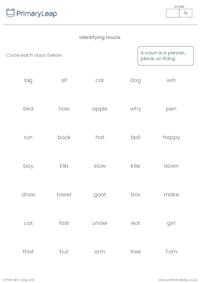
Identifying nouns activityAligned with language development objectives, this worksheet focuses on a fundamental aspect of grammar—nouns. By honing their ability to identify nouns, students lay a solid foundation for more advanced language skills. This engaging activity will help to sharpen students' grammar skills by identifying and circling nouns. In this interactive exercise, students will circle each noun, strengthening their understanding of this essential part of speech.
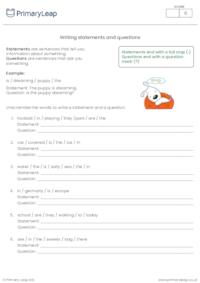
Writing statements and questionsThis worksheet is designed to reinforce the understanding of statements and questions by unscrambling words to create coherent sentences. Students will practise forming both statements and questions using the provided word sets.
 Free
Free
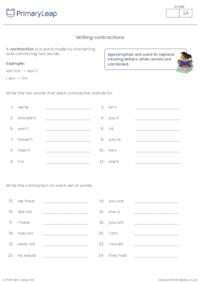
Writing contractions worksheetThis worksheet is designed to reinforce the understanding of contractions by matching them with their corresponding two-word forms. Students will practise recognising and forming contractions for common word pairs.
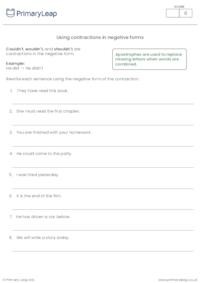
Using contractions in negative formsThis worksheet aims to reinforce the understanding of negative contractions by transforming sentences into their negative form. Students will practise using contractions such as couldn't, wouldn't, and shouldn't to express negation.
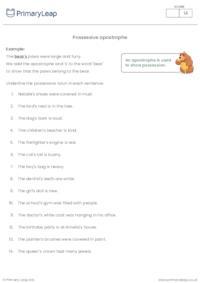
Possessive apostrophe worksheetThis worksheet will help to reinforce the concept of possessive nouns and their usage of apostrophes. Students will practise identifying possessive nouns in sentences by underlining them, promoting an understanding of ownership in language.
 Free
Free
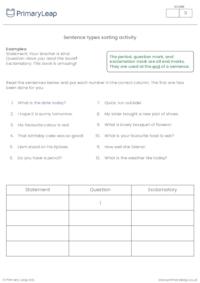
Periods, question marks, and exclamation marksUse this worksheet to help students practise identifying and categorising different types of sentences—statements, questions, and exclamatory sentences. By reading sentences and placing them in the correct column, students reinforce their understanding of sentence types.
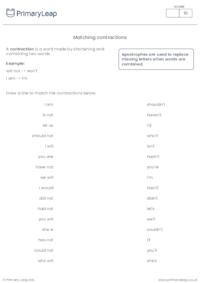
Matching contractionsWith this worksheet, students are asked to draw lines to connect contractions with their corresponding expanded forms, practising the recognition of common contractions.
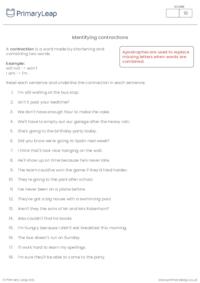
Identifying contractionsUse this resource to help students practise identifying contractions within sentences. By providing sentences containing contractions, students will read each sentence and underline the contraction present, reinforcing their understanding of how contractions are formed.
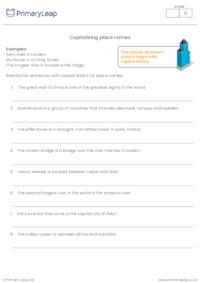
Capitalising place namesThis handy worksheet aims to reinforce the proper capitalisation of place names within sentences. By providing sentences with lowercase place names, students will practise rewriting them with correct capitalisation, enhancing their understanding of language conventions.
 Free
Free
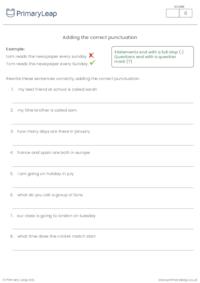
Adding the correct punctuationUse this great resource to help your students practise using correct punctuation in sentences. By providing sentences without proper punctuation, students will rewrite them with accurate punctuation, reinforcing their understanding of sentence structure.
 Free
Free
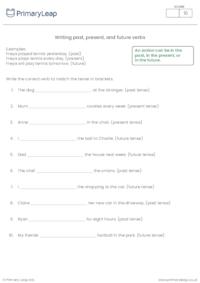
Writing past, present, and future verbsUse this worksheet to help students practise matching verbs to their appropriate tenses, including past, present, and future. By providing sentences with gaps, students will fill in the blanks with the correct verb form based on the specified tense in brackets.
 Free
Free
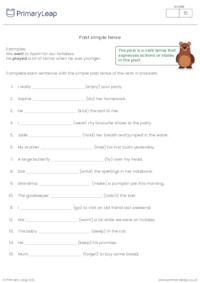
Past simple tense activityUse this handy worksheet to help students practise and reinforce their understanding of the simple past tense. By completing sentences with the correct past tense forms of verbs, students will enhance their ability to express actions that occurred in the past.
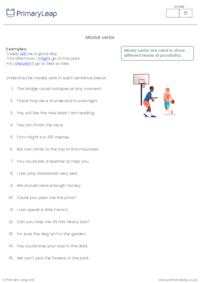
Identifying modal verbs activityUse this helpful worksheet to reinforce students' understanding of modal verbs by engaging them in an activity that involves underlining modal verbs in given sentences. Modal verbs express possibility, necessity, ability, or permission, and this activity is designed to enhance students' recognition and usage of these verbs.
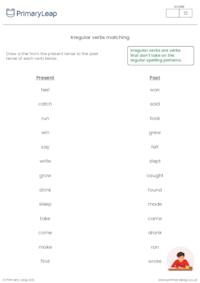
Irregular verbs matching activityUse this worksheet to help reinforce students' understanding of verb tenses, specifically the transition from present tense to past tense. By providing a list of verbs, students will draw lines connecting each verb to its corresponding past tense form, reinforcing their ability to conjugate verbs accurately.
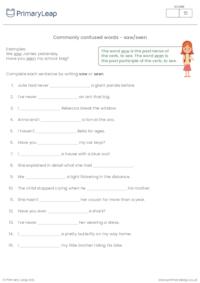
Commonly confused words - saw/seenThis worksheet is designed to reinforce students' understanding of the verbs "saw" and "seen" in different contexts. Through completing sentences, students will practise choosing the correct form of the verb to accurately convey past events and present perfect actions.
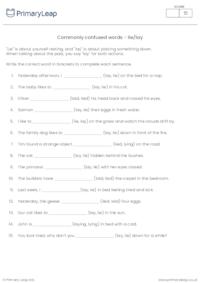
Commonly confused words - lie/layThis worksheet will help students distinguish between "lie" and "lay" when discussing actions related to resting or placing something down, particularly when referring to past events. Through a series of sentences, students will practise selecting the correct word in brackets to complete each sentence, enhancing their understanding of verb usage in different contexts.
 Free
Free
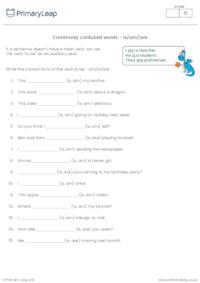
Commonly confused words - is/am/areThis handy worksheet is designed to reinforce students' understanding of the verb "to be" as an auxiliary verb when a sentence lacks a main verb. Through a set of exercises, students will practise selecting the appropriate form of "to be" (am, is, are) to complete sentences correctly, enhancing their awareness of auxiliary verb usage.
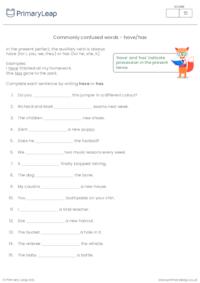
Commonly confused words - have/hasThis worksheet is crafted to reinforce ESL students' understanding of the present perfect tense and its auxiliary verbs, "have" and "has." Through a series of sentences, students will practise choosing the correct auxiliary verb based on the subject, fostering a solid grasp of present perfect construction.
 Free
Free
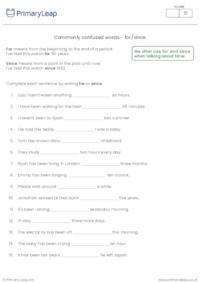
Commonly confused words - for/sinceThis worksheet aims to provide students with a clear understanding of the distinctions between the usage of "for" and "since" when expressing duration or time. Through contextual exercises, students will practise choosing the appropriate word to complete sentences, enhancing their grasp of these temporal prepositions.
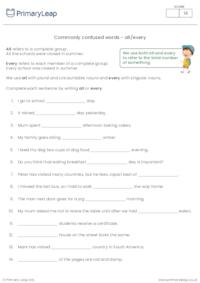
Commonly confused words - all/everyThis worksheet provides a practical and focused exercise for students to practise using "all" and "every" appropriately in sentences. It will help students grasp the distinction between "all" and "every" when used with different types of nouns. By completing sentences with the appropriate word, students will reinforce their understanding of when to use "all" with plural and uncountable nouns and "every" with singular nouns.
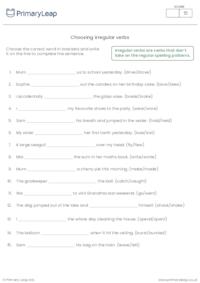
Irregular verbs activityThis worksheet is designed to reinforce students' understanding of irregular verbs by providing sentences with gaps. Students are tasked with selecting the correct irregular verb in the past tense to complete each sentence. This exercise aims to enhance their ability to recognize and use irregular verbs in context.
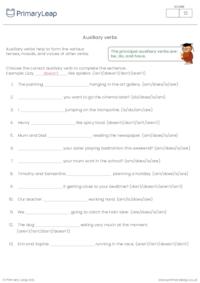
Auxiliary Verbs ActivityThis handy worksheet is designed to help ESL students grasp the concept of auxiliary verbs and their role in forming different tenses, moods, and voices of other verbs. By providing sentences with gaps, students are challenged to select the appropriate auxiliary verb, enhancing their understanding of verb conjugation and sentence structure.
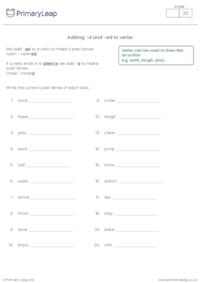
Past Tense Magic!This worksheet aims to reinforce students' understanding of forming the past tense of verbs, specifically focusing on the rules of adding -ed to regular verbs and -d to verbs ending in a silent "e." By engaging with a variety of verbs through visual examples, students will enhance their grasp of these fundamental grammar concepts.
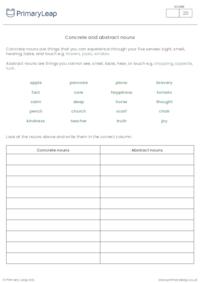
Concrete and abstract nouns sorting activityThis resource is designed to help students differentiate between nouns that can be experienced through the senses (concrete nouns) and those that cannot (abstract nouns). This worksheet not only reinforces the understanding of concrete and abstract nouns but also encourages students to apply this knowledge in future language activities and writing exercises. Use this resource to strengthen your students' vocabulary and language comprehension while making grammar concepts accessible and enjoyable.
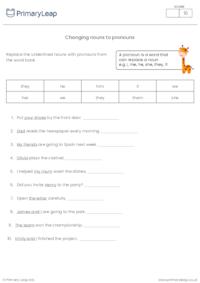
Changing nouns to pronouns worksheetThis handy worksheet engages students in actively replacing underlined nouns with appropriate pronouns from the word bank. This hands-on approach encourages participation and boosts comprehension. By incorporating this worksheet into your ESL curriculum, you provide students with a valuable tool to reinforce their understanding of pronouns. Students are asked to replace the underlined nouns with pronouns from the word bank.
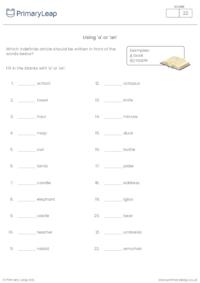
ESL Grammar: Using 'A' or 'An'Practise using 'a' and 'an' with your ESL/EFL students with this handy worksheet. Students read the list of words and write 'a' or 'an' to complete the exercise. What are indefinite articles?Indefinite articles are a type of determiner used in English grammar to introduce nonspecific or unidentified nouns. There are two indefinite articles in English: "a" and "an." The choice between "a" and "an" depends on the sound that follows the article, not the actual first letter of the noun."A": Use "a" before words that begin with a consonant sound.Example: "I saw a cat in the garden.""An": Use "an" before words that begin with a vowel sound.Example: "I found an interesting book at the library."
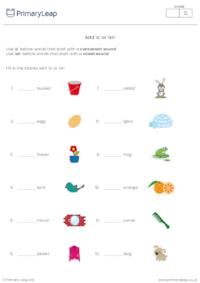
What are indefinite articles?Indefinite articles, specifically "a" and "an," are used to refer to non-specific items or things. The choice between "a" and "an" depends on the sound that follows the article:"A": Use "a" before words that begin with a consonant sound. For example:"I saw a car in the carpark.""An": Use "an" before words that begin with a vowel sound. For example:"I saw an owl in the tree."By incorporating this worksheet into your ESL curriculum, you provide students with a valuable tool to sharpen their English language skills.
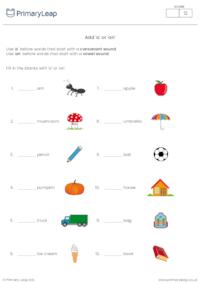
"A" and "an" are the indefinite articles in English. They are used before a noun to indicate that the noun refers to something non-specific or not known to the reader or listener. The choice between "a" and "an" depends on the sound that follows the article, not the actual first letter. For example:"I saw a cat in the backyard.""I saw an interesting movie yesterday."It's important to note that the choice between "a" and "an" is based on the sound that follows the article, not the actual first letter. For instance, "an hour" is correct because "hour" begins with a vowel sound, and "a university" is correct because "university" begins with a "ju" sound, which is a consonant sound.With this worksheet, students fill in the blanks with 'a' or 'an'.
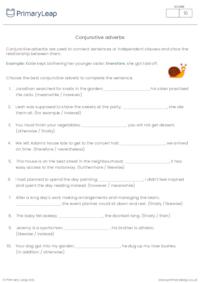
ESL Conjunctive Adverbs ActivityThis handy worksheet is designed to guide ESL students in mastering the use of conjunctive adverbs to connect sentences or independent clauses. By choosing the most fitting conjunctive adverb to complete sentences, students will develop a nuanced understanding of how these adverbs enhance sentence relationships.
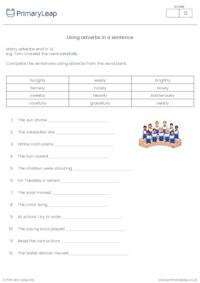
Using adverbs in a sentenceBy completing sentences with adverbs from the provided word bank, students reinforce their understanding of how these adverbs contribute to how actions occur. The exercise reinforces the association between adverbs and the description of how an action takes place. The task of completing sentences with adverbs promotes active participation, making the learning experience dynamic. This worksheet is a valuable resource for educators seeking to strengthen grammar skills, enrich vocabulary, and provide practical exercises for ESL students to proficiently use adverbs ending in 'ly' in their language development.
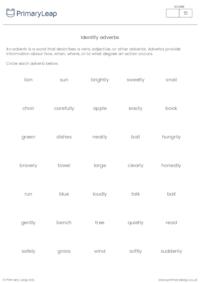
Identify adverbs worksheetBy circling adverbs, students will reinforce their understanding of how adverbs enhance language by providing information about how, when, where, or to what degree an action occurs. This worksheet is a valuable resource for educators seeking to reinforce grammar skills, improve contextual understanding, and provide practical exercises that empower ESL students to recognise and use adverbs effectively.




Check out our ready-to-use worksheets that can be used in the classroom or at home. Simply download or print and watch your child’s confidence grow with our easy to follow printables.


One of the best things about printable worksheets is that they make learning fun and easy. Explore our educational resources based on and keep your children learning through these fun and engaging exercises.


Our printable worksheets are designed for progressive learning. Our engaging content enables a child to learn at their own speed and gain confidence quickly. When we help a child believe in themselves, we empower them for life.


Printable worksheets are a great way to enhance creativity and improve a child’s knowledge. Help your child learn more about with this great selection of worksheets designed to help children succeed.
An email has been sent to your account please activate your account to continue.

PrimaryLeap has introduced a new interactive learning platform and would like to offer you a completely Free Upgrade.
We understand that you may only want to use our services for worksheets and may not want to upgrade your account.
But if you are interested in trying out our new services then you're just a click away.
An email has been sent to your account please activate your account to continue.
You've answered
and have 2 Questions remaining
Import multiple students information through a CSV File. Browse or drag .CSV file below.